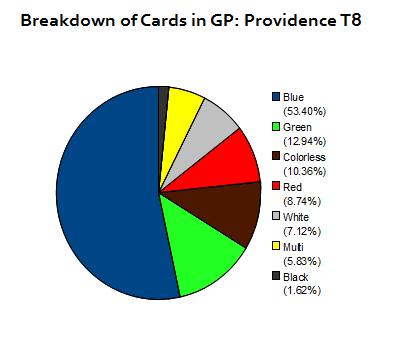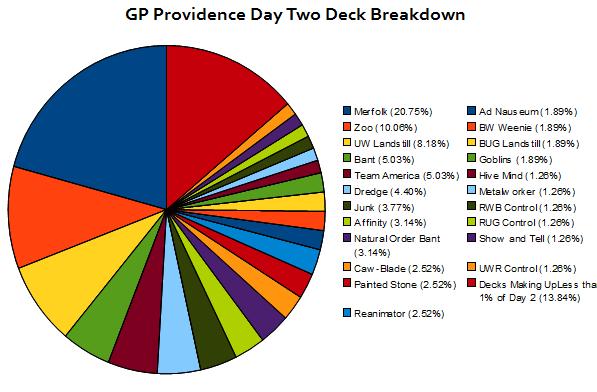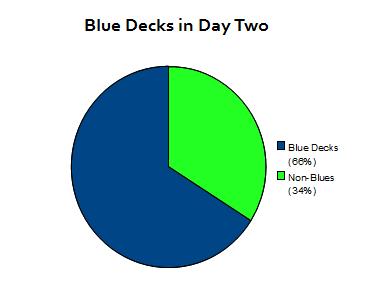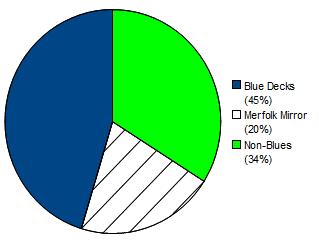Introduction
While I was busy with obligations over Memorial Day weekend, 1,179 players battled in Providence for the biggest stateside Legacy tournament of the year. I doubt anyone would have predicted that a Hive Mind deck would make the finals, let alone that a deck without Force of Will would rise over it in the end. With his interesting Bant deck, James Rynkiewicz can now live not as the man with awesome Beta duals who lost to AJ Kerrigen in a feature match, but instead as the man with sweet Beta duals who became the first primarily Legacy player to win a Legacy Grand Prix. The reasons why this is significant are covered in a previous article I’ve written, but for some, it will finally prove that players who focus on Legacy can also be rather skilled Magic players.
The Man and the Deck
I don’t know him personally, so I used the Internet to learn a bit about our newest Legacy Grand Prix champion. It’s not as though James Rynkiewicz has come out of nowhere; he’s had several placings and even a few wins at large events over the last year before the Grand Prix. First, there was a 116-player Black Lotus event where he won with U/G Survival. At SCG: Boston in 2010, he used U/G/w Survival to take down the 218-man event. He went on to win a trial in March with Team America and split an event at Jupiter Games with a build of the deck strikingly similar to what he used to storm the Grand Prix just a couple weeks prior. Speaking of the deck, I’d like to talk about it:
"NoFoW, by James Rynkiewicz (first place at Grand Prix: Providence)"
- Creatures (14)
- 1 Birds of Paradise
- 1 Tarmogoyf
- 2 Qasali Pridemage
- 2 Stoneforge Mystic
- 3 Knight of the Reliquary
- 3 Noble Hierarch
- 2 Vendilion Clique
- Planeswalkers (2)
- 2 Jace, the Mind Sculptor
- Spells (22)
- 3 Daze
- 3 Mental Misstep
- 4 Brainstorm
- 4 Swords to Plowshares
- 4 Green Sun's Zenith
- 2 Sylvan Library
- 1 Sword of Feast and Famine
- 1 Umezawa's Jitte
- Lands (22)
- 1 Forest
- 1 Dryad Arbor
- 1 Maze of Ith
- 2 Savannah
- 2 Tundra
- 3 Tropical Island
- 3 Wasteland
- 4 Misty Rainforest
- 4 Windswept Heath
- 1 Karakas
- Sideboard (14)
- 1 Sylvan Safekeeper
- 2 Rhox War Monk
- 1 Gaddock Teeg
- 1 Thrun, the Last Troll
- 1 Dispel
- 1 Mental Misstep
- 1 Path to Exile
- 2 Krosan Grip
- 3 Spell Pierce
- 1 Bojuka Bog
The first comment I want to make about this deck is that while most people are going to call it Bant, he named the deck NoFoW, which makes sense, but it reminds me of the time U/W Tempo was named NoGoyf, because it didn’t play Tarmogoyf. This sort of naming convention ended up confusing many people because of decks like NOBant, so I don’t see the name sticking.
In his Top 8 player profile, James says that he wanted to build New Horizons without Force of Will, but when I look at it, the deck looks like quite a distant relative of New Horizons, which looks a bit more like this:
"New Horizons"
- Creatures (10)
- 2 Terravore
- 4 Knight of the Reliquary
- 4 Tarmogoyf
- Planeswalkers (0)
- Spells (28)
- 2 Spell Snare
- 3 Daze
- 4 Brainstorm
- 4 Force of Will
- 4 Mental Misstep
- 4 Stifle
- 4 Swords to Plowshares
- 3 Ponder
- Lands (22)
- 1 Island
- 3 Horizon Canopy
- 3 Tropical Island
- 3 Tundra
- 4 Flooded Strand
- 4 Misty Rainforest
- 4 Wasteland
- Sideboard (15)
- 2 Rhox War Monk
- 2 Krosan Grip
- 2 Path to Exile
- 2 Spell Pierce
- 3 Submerge
- 3 Tormod's Crypt
- 1 Bojuka Bog
The distinct changes from list to list are a bit lengthy, but you can see that one of these is an aggro/control plan centered around huge creatures and mana disruption, while the other is using Green Sun's Zenith to leverage maximum control over a game state. I think that James’s deck is actually looking a lot more akin to the G/W decks we’ve seen recently, but splashing Blue to compensate for the deck’s weaknesses. If we look at it from that angle, then, it’s a lot easier to visualize the decision-making process for the changes. Many G/W pilots have been complaining recently about the relative weakness of Tarmogoyf, so James only played a single copy. Mother of Runes is a card that a lot of people have been disparaging for some time now, so that comes out for Mental Misstep. Brainstorm is an obvious inclusion over whatever is deemed to be the worst creature, and Vendilion Clique fits nicely in with the suite of utility creatures that the G/W decks play so many of.
You can see how the list has been lovingly tuned; there is really no chaff to be seen in the deck. James understood that while he is likely to win the game off a resolved Stoneforge Mystic, he only has need of a couple of pieces of equipment, cutting the popular Sword of Fire and Ice and not trying the tricks that other people were. Because he was using so few equipments, that meant that late-game Mystics had a good chance of being Squires, which is something you’d ideally avoid, so he played a reasonable number of them. Jace seems to be in the deck as his major way to fight an opposing Jace, generally a bane to any Bant deck. The board goes in depth in addressing what he knew were bad matchups: Sylvan Safekeeper turns off many of control’s tools, Rhox War Monk shores up the aggro match where he is lacking a lot of the defensive creatures he may otherwise have, and Spell Pierce works to put a stop to any of combo’s early game plans until he can find a Vendilion Clique.
Even after I found myself nodding in agreement with a lot of these changes, there were a number of choices that left me quite confused, such as the split of three Noble Hierarchs and one Birds of Paradise. I can see some instances where you want Birds over Noble Hierarch: in the face of Phyrexian Revoker, if your opponent is at one and you need to get over a Moat, blocking lethal damage in the air, and of course holding Sword of Feast and Famine. I’m not sure how much better it truly is than playing the fourth Hierarch, which is nearly always going to have an impact on the game, even if it’s effectively turned off by Phyrexian Revoker. The other major concern I have is Jace, the Mind Sculptor; I’ve always been skeptical of the card in aggro/control decks, because I find that it’s good against the good matches and lacking where you need help. Great examples of this would be when playing against combo and Zoo, which both look rough for this deck, where Jace is ultimately going to be rather slow—turn three at the fastest, and generally ineffective at most stages of the game. I can, however, accept that this may have been a concession to control being expected in large numbers, but I think that Bant may still have better solutions.
Top 8 Fact Sheet and Thoughts
For reference, check out the Top 8 in the official Grand Prix coverage.
No two decks in the Top 8 repeated. This is exactly what we saw last year and what most people expected; however, I was not among them. I anticipated that because Merfolk was so well positioned in this tournament, no fewer than four Merfolk decks would Top 8. I was wrong.
By my count, the Top 8 was evenly split among the four distinct strategies in Legacy: two decks representing control, aggro-control, aggro, and combo. It’s interesting to consider that even with eight different decks, there was still an excellent cross-section of archetypes represented, even if they were nearly all Blue-based.
Of all the decks in the Top 8, only one of them played without Blue (Zoo). Zoo was the second-most-common Day 2 archetype, which we’ll look at more in depth later, but it shouldn’t be surprising that an aggressive Zoo build was able to bash through fourteen rounds.
Every player who made Top 8 had at least one bye. Only one player had one bye (Zoo). Reid Duke was the only player to have two byes, and every other player in the Top 8 enjoyed three rounds of byes. The value of byes in a tournament is huge, and this is an excellent representation of exactly why that is. Byes tend to be a controversial subject in Legacy events, so I won’t talk too much about them here.
Daniel Brooks, who finished in ninth place, was the highest-finishing player with no byes. I was quite pleased to learn that someone without a privileged position came in and did so well, although it’s sad to think that he fought for two days only to miss out on breakers. The player who came in eighth and beat him by 4% in OMW had a three-round bye. I found out from Matt Elias via Twitter that Daniel played Dredge, which was an archetype that people commonly believed to be dead. I’m sure it makes for an interesting story.
With eight distinct decks, it isn’t relevant to do a breakdown of the decks, so what I’ve done is chart the trends we did see. I’ve made this pie chart to help visually represent some aspects of the Top 8, and I’d like to discuss what this means.

This chart shows the breakdown of the spells that made up the decks in the Top 8 of the Grand Prix. It’s not a surprise that most of these cards are Blue, and that Green makes up the second-biggest portion. One of the two matters that are striking to me is the number of Red cards; this quantity is much higher than I would expect, even surpassing White by a slim margin. It’s intriguing that nearly all of the Red cards cost 1 despite the fact that Mental Misstep is quite good against 1-drops. The other surprise to me is the lack of Black cards in this chart; there were exactly five, all with different names and all from the same deck. No sight of Dark Confidant and not a single Hymn to Tourach in the main deck of any Top 8 competitor, both of which were powerhouse cards that many people couldn’t stop making excuses to play. Without the Top 32 deck lists I can’t make truly informed statements about the metagame, but the lack of such highly anticipated cards is staggering nonetheless. As more lists and reports come out from the Grand Prix, I’ll look more into what the top tables looked like.
Digging more into the above graph, it should be no surprise that the most-played cards in the Top 8 were all Blue, considering that Blue makes up half the total cards. What was a surprise to me is that Mental Misstep was in fact the most common card among main decks—more than Force of Will, more than Brainstorm, Mental Misstep was in every deck but one, giving it twenty-five of a possible thirty-two slots. James Rynkiewicz wasn’t the only player to cut Force of Will for Mental Misstep; we saw Merfolk playing with only three Forces and the Hive Mind deck playing three as well. Maybe Adam Barnello was right, and Mental Misstep truly is Force of Will. The second-most-played card is Brainstorm, played in every deck except Merfolk and Zoo as a four-of, giving it twenty-four copies, then Force of Will with twenty-two copies. Moving down the list, Daze has twelve slots in the top, and rounding out the most-played Blue cards is Jace, the Mind Sculptor with nine.
No other color managed to have more than nine copies of a card in the Top 8, so at that point we can start counting down most commonly played cards by color.
Green – Tarmogoyf (9) – There should be no surprise here; Tarmogoyf has been a staple of Legacy since the day it was legal. Tarmogoyf’s power has made people clamor for banning the card or at least printing a card that kills all creatures with the Lhurgoyf creature type. Zoo and NO R/U/G both played four copies, but the champion played but a single copy of the monster, fetchable via Green Sun's Zenith. Honorable mentions go out to Noble Hierarch (7) and Green Sun's Zenith (7), which are both Green staples that we commonly see supporting our friend Tarmogoyf.
White – Swords to Plowshares (8) – The best removal is still the best, even if it can be countered by additional spells. Swords to Plowshares has been the reason to play White for years and years, and is now supplemented by the second-most-played White card, Stoneforge Mystic (6). To some people, it may be a surprise that this card saw so much play at the Grand Prix, let alone putting decks into the Top 8; however, for some others, this was expected. I’ve told people that Stoneforge is the new Tarmogoyf, and that sentiment seems to be becoming more clear as control archetypes as well as aggro plans are developing around the creature. Batterskull was something I’d done testing with and was quite happy with in Legacy; the plan of Stoneforge getting a 4/4 creature is quite relevant at most stages of the game, not to mention the other helpful tricks the Mystic can pull off. Expect to see a lot more Stoneforge Mystics in the coming months.
Red – Lightning Bolt (8) – Conditional removal that can reach all the way to the opponent seldom gets better than Lightning Bolt. Both Zoo and NO R/U/G played this in their main as four-ofs. The second-most-common Red cards are tied between Chain Lightning (4), which was played as two-ofs in each of those decks, and Goblin Welder (4) from the Painter deck. The only Red cards that were not 1-drops in the Top 8 were Pact of the Titan (3) and Price of Progress (2).
Black – The only Black cards were the one-of mixes in PV’s Landstill; when including sideboards, the most common Black spell is actually Leyline of the Void (4). This was not the event for Black, judging from these results. Even Qasali Pridemage (6) saw more play than any single Black card in the top.
A Broader View – A Look at Day 2
The Day 2 metagame has a lot of valuable data that we can dig into. If you’d like to take a look at the Wizards coverage and metagame breakdown, you can check it out here. Before I start digging into it, I’d like to say that I was very happy with the work that was put into properly identifying the archetypes this year, unlike what we saw in Columbus last year; excellent work, coverage staff.
On the coverage page, you can find the specific numbers for all the Day 2 decks which can be seen in chart form, or seen a bit more visually, like this:

Obviously, even when only looking at decks that had several copies in Day 2, this view is very chaotic and difficult to draw any value from. Considering this, what I wanted to do was sort these decks by archetype and examine them further from there. These were the numbers I divided the decks into:
62 aggro decks
41 aggro-control decks
29 combo decks
27 control decks
Visually, this looks like:

The two most popular decks in the format are aggro—Merfolk (20%) and Zoo (10%). Aside from those decks, only about 9% of the field were decks with purely aggressive strategies. Aggro control, including most U/G/X decks, accounts for the second-biggest portion of the pie, making up one in four decks. Bant (5%) and Team America (5%) each put eight of their pilots into Day 2. Dredge (4%) was the most common combo deck to make Day 2, with many fringe decks putting one or two copies in behind it. When we look at control, U/W Landstill (9%) variations represented the vast majority of control, with other decks only putting a few copies into Day 2.
Blurbs on Popular Decks
Merfolk
The first deck I want to talk about in depth is Merfolk. To understand Merfolk’s role in the tournament, we should look at the following:

These numbers are important because all Blue decks are inherently disadvantaged against Merfolk. However, we must consider that in Day 2, one in five decks was Merfolk, which actually is a 50/50 match. To reflect that, we can use the following representation:

This means that coming blindly into the field, a Merfolk player has a greater than 50% match win percentage against nearly half the decks, 50% against a fifth of the decks, and numbers that range from highly unfavorable to somewhat favorable against the remaining third of the metagame. This is great for Merfolk players, since it suggests that you have the best deck in the room. Most serious players are going to be inclined toward Blue strategies, which means you’ll be favored against many the best players and you can use the sideboard to address problem matches. I’m certain that because of the saturation of Merfolk in Day 2, the percentage of Blue decks in Day 1 was actually higher than in Day 2. Remember these results for when you’re considering the next deck you take into an event.
Zoo
Many people were quite surprised to see that Zoo was the second-most-common deck to make Day 2 in Providence, but with Merfolk being the most common deck in the format, Zoo is going to be highly favored against a good part of any large field. Zoo can also do quite well against control decks, as my good friend Gandhi Jagasia has shown me over the years. I suspect that the most successful decks were builds that kept Merfolk in check while both using aggressive creatures like Steppe Lynx and Goblin Guide and using control-punishing cards such as Elspeth, Knight-Errant and Sulfuric Vortex.
The existence of Mental Misstep doesn’t change the fact that Zoo is the most consistent deck in the format and as such is going to have an easy time punishing every other deck’s variant draws. Zoo has since gone on to be the first-place deck in the SCG Invitational as well as an appearance in the BoM V Top 8 last month. Zoo isn’t going anywhere for the time being.
U/W Landstill
After the initial resurgence of the deck just a couple of weeks prior, it became clear that this was going to be the first time in a long time that anyone needed to prepare for a control-heavy metagame. Even despite preparations against the deck, Landstill was the third-most-common deck in Day 2, making up just a bit less than Zoo. Landstill’s strength is that it’s able to squeeze the aggro-control decks out of contention with overwhelming card advantage and a surplus of removal and trumps. Merfolk and some Zoo builds are always going to be around as a counter, but Landstill with and without Stoneforge Mystic is now the premier control strategy in the format.
Bant/Team America
Bant was a deck we were seeing a lot less of than I thought we would, and Team America is a deck that I thought we’d be seeing a lot less of, so these parallel results in Day 2 made sense to me. Bant should be gaining even more strength with the shifting format, and Team America, along with U/b/g tempo clones, should be losing steam as the format matures a bit more.
Dredge
Most people counted Dredge out of this event, but it shouldn’t be surprising at all that the deck did so well, considering that the above decks are all positive matchups even with Mental Misstep around. Speaking of which, the idea that Dredge is entirely cold to Misstep is false; we’ve seen lists of the deck that use Lions Eye Diamond to great effect, and it shouldn’t be a surprise when we see lists packing Tolarian Winds to generate instant wins around Mental Misstep.
Conclusion
Last year, Stephen Menendian was able to get all of the lists for Grand Prix: Madrid, which means that a lot of information from that event was made public. I don’t know if there is a writer who has the lists for Day 1, but without them, it’s not possible to see the percentage of each strategy that was able to penetrate to Day 2, which would be quite interesting. I hope that over the coming weeks, we’re able to see that information surface.
I have a lot to think about after this weekend. I went to SCG: Indianapolis over the weekend and had a pretty good time despite having my day ruined early by Merfolk—I really need to stop playing decks that are so bad against Merfolk! Drew Levin was kind enough to sign a pair of Gambles for me, which was among the highlights of the weekend. A couple friends of mine did well, and one of them even played Sun Titan in a large Legacy event, to the dismay of many Merfolk players. I did some trading and met a lot of great people with whom I was able to discuss theory and get an understanding of how newer Legacy players are viewing the format. Next week, I’d like to discuss the role of Merfolk in Legacy and start a theme of discussing the impact of each major deck in the metagame, what it beats, and how to beat it.
~ Christopher Walton in the real world
im00pi at gmail dot com
Master Shake on The Source
@EmperorTopDeck on Twitter























